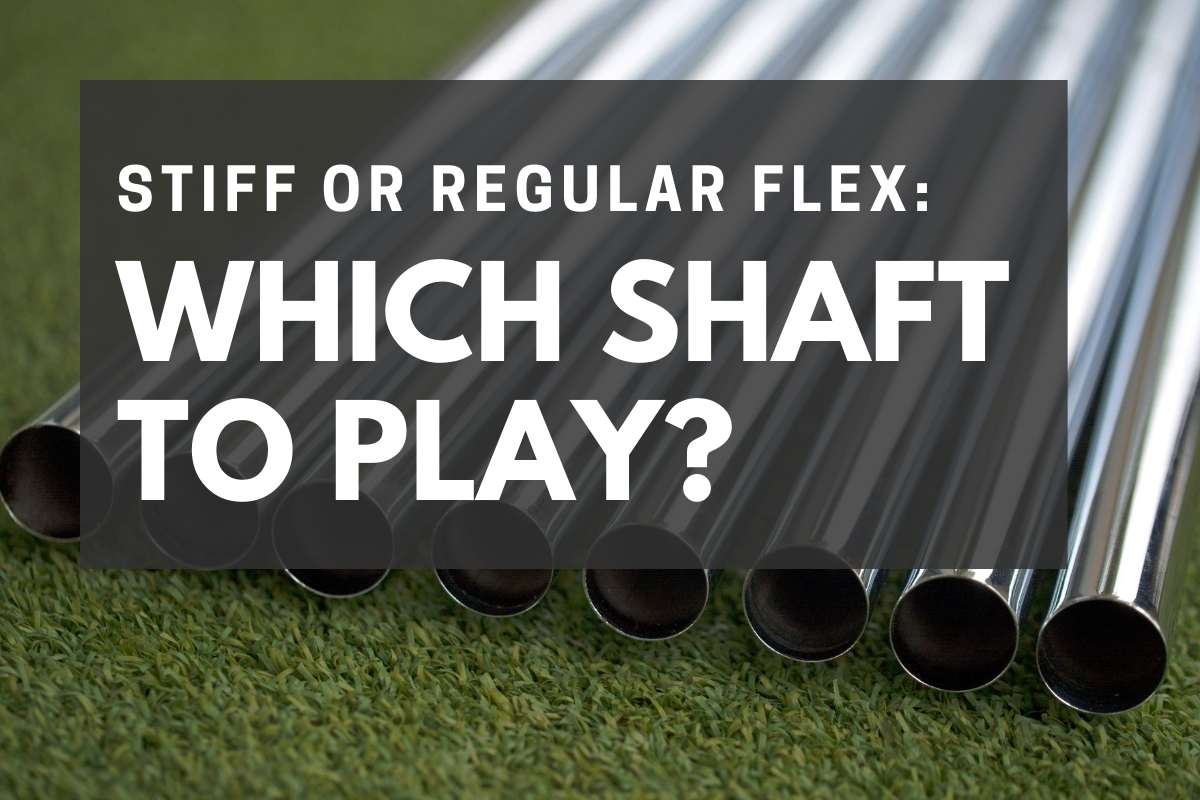The shaft is the engine of the golf club, and selecting the right shaft flex is perhaps the most important aspect when choosing golf clubs. What happens if the flex is wrong? You will have ball flight, distance, accuracy, and consistency issues.
Most amateur golfers are stuck choosing between stiff vs. regular flex. For some players, this is a very clear cut decision; for others, there is a bit of a dilemma that needs to be sorted out. Let’s take a look at the difference between stiff and regular shaft and which one would be best for your game.
What’s The Difference Between a Stiff and a Regular Shaft?
Stiff flex shafts are stiffer and less flexible than regular shafts. Regular flex essentially means that the shaft allows for more bend as you swing the club.
Shaft manufacturers developed different flexibility levels to meet the needs of the golfer’s swing speed and tempo.
In simple terms, “flex” is the extent to which a shaft bends at various points of the golf swing, primarily on the downswing through impact.
As more force is applied on the shaft (i.e., the harder you swing it), the more the shaft will flex and “snap” through impact, giving the club more head speed through the ball and more distance. Naturally, the slower you swing, the less flex is generated in the shaft.
Is Stiff or Regular Shaft Better For Me: How To Decide
Now that you have an idea of what the differences are between stiff and regular shafts, its time to determine which will be the right fit for your game. There are a variety of factors to look at here. If it were as easy as swing speed, it would make golf much simpler!
Swing Speed
The most common way to determine if a golf shaft is a right fit for your game is to look at your driver’s swing speed number. The driver’s swing speed can tell a lot about a person’s golf game. The slower you swing the club with your driver, the more flexible a golf shaft that you will need.
One of golf’s most important and overlooked issues is how the swing speed changes from one club to the next. Almost all golfers swing their drivers faster than they swing their irons. With the weight of the club and the aggressive nature that golfers have, the driver’s swing speed is high.
This is why it’s important to also look at your irons’ swing speed before settling on the perfect golf shaft option for your game.
Sometimes the shaft you have in your driver will be stiff, and the shaft you have in your irons is a regular. We see this being the case with players who use steel shafts quite often. The weight differences in the shafts will impact overall performance.
In the end, a golfer with a driver swing speed in the low 90s will use a regular flex; high 90s and low 100s need to switch to the stiff flex. Once you get in that 105-110 range, the X stiff is the best option.
| 6-iron Carry Distance | 6-iron Swing Speed | Driver Swing Speed | Shaft flex (all clubs) |
| < 130 yards | 60 – 70 mph | 75 – 85 mph | Senior Flex |
| 131 – 155 yards | 71 – 80 mph | 86 – 95 mph | Regular Flex |
| 156 – 175 yards | 81 – 90 mph | 96 – 105 mph | Stiff Flex |
| > 176 yards | 91 + mph | 105 + mph | X-Stiff Flex |
Stamina/Strength
It’s great that you can swing a golf club at 110 mph, but the real question is whether or not you can do this through 18 holes of golf. We all can go after a ball from time to time and get quite a bit of distance, but when you are deciding between stiff and regular shafts, you must look at what you can consistently repeat.
If you swing the club 95 mph consistently and every once in a while get one to 100, you may feel best with the regular shafted golf club.
Sometimes golfers will work on swing speed by getting stronger and making physical fitness a priority. If you do this, check to ensure that your golf shaft is still the right choice.
Ball Flight
As a general rule, the ball flight decreases as the shaft gets stiffer. Of course, golfers with high swing speeds will not see this happen. Higher swing speed golfers can compress the ball and still see very high ball flight when they are using a stiff shaft.
For years golfers thought that hitting the ball low would give them more carry distance and better overall performance. We now know that this is not the case. Players must get the ball up in the air and reach a peak height to get maximum distance out of their shots.
Shaft Weight
Shaft weight also plays into the overall performance. The heavier your golf shaft, the harder it is to hit the ball high. For golfers with fast swing speeds, the heavier shaft weight is used to bring ball flight down and increase overall accuracy in the golf shots.
Golf shaft weight can be an issue that many amateur golfers don’t understand or even notice. Take a look at your driver and iron shots and consider how high they fly. The higher the golf ball, the easier it is to get it to stop on a green, but if it costs your distance and control, a heavier shaft is necessary.
Shaft Material
A graphite shaft and a steel shaft do not perform the same way. Steel golf shafts are heavier and easier to control, but they can cost players a few yards of distance. Graphite shafts are traditionally more lightweight, have higher ball flight, and have a bit less consistency.
There are positives and negatives to both graphite and steel golf shafts.
However, when you are deciding which shaft material is best for your game, the graphite vs. steel decision needs to come into play.
Related: Graphite vs. Steel Shafts: Which is right for your golf game?
Dynamic vs. Static Golf Club Fitting
Golf club fittings are a great way to help you decide between a regular and stiff flex in your golf clubs. The golf club fitting is especially important for the player that is borderline and having a hard time deciding which golf clubs are right for them.
When looking at the dynamic vs. static golf club fitting, the dynamic fitting takes into account all the things about you as a golfer. This looks at the angle of descent, the way your club face approaches the ball, your weight transfer in your swing, and more. With the static club fitting, we simply choose a club based on your height, arm length, and swing speed.
Both the dynamic and static fitting are helpful, but as you may imagine, the dynamic fitting uses the current technology in the game to help us make better decisions about which clubs to play.
What Happens if you Have the Wrong Flex?
If you have the wrong flex in your shaft for your particular swing characteristics, you will not strike the ball consistently, and it will lead to decreased accuracy.
Players with high swing speed already produce enough flex in the shaft and do not need the additional help that a regular flex shaft may provide. This shouldn’t come as a surprise—a flexible shaft will move the clubhead more throughout the downswing, which increases the likelihood of the clubface getting offline and not striking the ball squarely.
Failing to hit the ball squarely on the clubface is what produces those dreaded high slices and toe-hooks…or worse. On the other hand, a shaft that is too stiff for your swing can result in shots that are too low with little spin.
The biggest problem for golfers that have the wrong flex in place is consistency. Every golfer coils use more consistency in their game, but when you have the right shaft in place, it makes things much easier.
How Do I Know if my Flex is Regular or Stiff?
Not all regular and stiff shafts are created equally. One manufacturers stiff may be another one’s regular. However, there are some general guidelines when it comes to identifying flex ratings.
To determine what flex shaft you have, the label on your shaft will tell you. It will likely have a letter (referencing flex) and a number (weight in grams). Flex ratings are broken down as follows:
- Senior Flex (S or A)
- Regular Flex (R)
- Stiff Flex (S)
- Extra Stiff Flex (X)
Related: What is a Senior Flex Golf Shaft (vs. Stiff and Regular)?
If you think that the shaft you currently have in play is stiffer than another, you could always test it using a launch monitor. Take some swings with the shaft you currently have, and then use something of a different flex.
Take a close look at how the spin rates, carry distance, and total launch are compared between the two different golf clubs.
Related: What Shaft Flex Should You Be Playing? It may surprise you
Frequently Asked Questions
Here are a few of the most commonly asked questions about the stiff vs. regular shaft issue. If you are really having a hard time deciding which is best for you, consider going for a golf club fitting where each shaft you try can be analyzed and evaluated.
What Flex Should My Irons Be?
Golf irons should be regular if you have a 6 iron swing speed of 70 to 80 mph. If you are in the 81-90 range, the stiff flex tends to be the better choice. Try not to go with swing speed alone when deciding on the flex of your irons; look at ball flight, spin rates, and overall athletic ability.
What Flex Should By Driver Be?
Most golfers swing the driver faster than any other club in the bag. If you swing around 100 mph, the stiff flex is a great option. For those consistently less than 95 mph on the driver swing, the regular flex is a better choice.
Do Driver and Irons Need To Be The Same Flex?
Drivers and irons do not need to be the same flex. In fact, it is quite common for a golfer to have a stiff shaft in their driver and regular flex in the irons. Players find that it’s easier to swing a driver fast, and therefore the flex needs to be adjusted accordingly.
Is It Worth Reshafting My Golf Clubs?
Reshafting, your golf clubs is worth it if you have a shaft that doesn’t fit the needs of your golf game. The shaft is potentially more important in the overall performance of the club than the clubhead itself!
You may also be interested in:
Final Thoughts
For some golfers with consistent swing speeds and performance, the decision between stiff and regular golf shafts is an easy one. However, this decision becomes increasingly complicated when the swing speeds vary from day to day or hole to hole.
A golf club fitting can be a great way to determine if your golf shafts are the proper shaft flex for you; these fittings do not necessarily mean you need to purchase new clubs. Simply go in for a checkup and make sure that the equipment you are using is actually a proper fit for your golf game.




